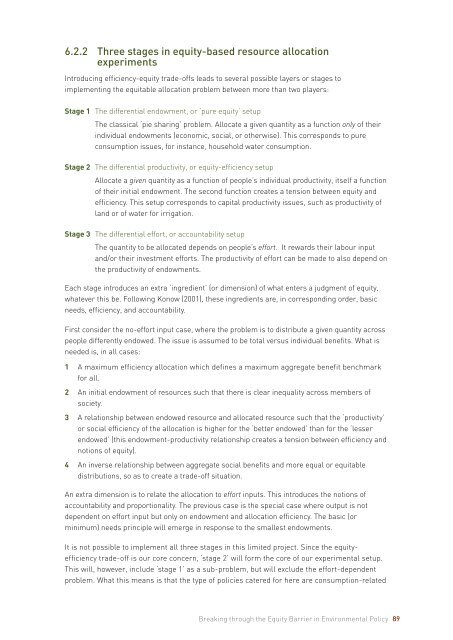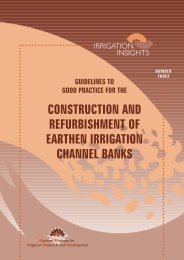Final Report Breaking through the Equity Barrier in Environmental ...
Final Report Breaking through the Equity Barrier in Environmental ...
Final Report Breaking through the Equity Barrier in Environmental ...
- No tags were found...
You also want an ePaper? Increase the reach of your titles
YUMPU automatically turns print PDFs into web optimized ePapers that Google loves.
6.2.2 Three stages <strong>in</strong> equity-based resource allocation<br />
experiments<br />
Introduc<strong>in</strong>g efficiency-equity trade-offs leads to several possible layers or stages to<br />
implement<strong>in</strong>g <strong>the</strong> equitable allocation problem between more than two players:<br />
Stage 1 The differential endowment, or ‘pure equity’ setup<br />
The classical ‘pie shar<strong>in</strong>g’ problem. Allocate a given quantity as a function only of <strong>the</strong>ir<br />
<strong>in</strong>dividual endowments (economic, social, or o<strong>the</strong>rwise). This corresponds to pure<br />
consumption issues, for <strong>in</strong>stance, household water consumption.<br />
Stage 2 The differential productivity, or equity-efficiency setup<br />
Allocate a given quantity as a function of people’s <strong>in</strong>dividual productivity, itself a function<br />
of <strong>the</strong>ir <strong>in</strong>itial endowment. The second function creates a tension between equity and<br />
efficiency. This setup corresponds to capital productivity issues, such as productivity of<br />
land or of water for irrigation.<br />
Stage 3 The differential effort, or accountability setup<br />
The quantity to be allocated depends on people’s effort. It rewards <strong>the</strong>ir labour <strong>in</strong>put<br />
and/or <strong>the</strong>ir <strong>in</strong>vestment efforts. The productivity of effort can be made to also depend on<br />
<strong>the</strong> productivity of endowments.<br />
Each stage <strong>in</strong>troduces an extra ‘<strong>in</strong>gredient’ (or dimension) of what enters a judgment of equity,<br />
whatever this be. Follow<strong>in</strong>g Konow (2001), <strong>the</strong>se <strong>in</strong>gredients are, <strong>in</strong> correspond<strong>in</strong>g order, basic<br />
needs, efficiency, and accountability.<br />
First consider <strong>the</strong> no-effort <strong>in</strong>put case, where <strong>the</strong> problem is to distribute a given quantity across<br />
people differently endowed. The issue is assumed to be total versus <strong>in</strong>dividual benefits. What is<br />
needed is, <strong>in</strong> all cases:<br />
1 A maximum efficiency allocation which def<strong>in</strong>es a maximum aggregate benefit benchmark<br />
for all.<br />
2 An <strong>in</strong>itial endowment of resources such that <strong>the</strong>re is clear <strong>in</strong>equality across members of<br />
society.<br />
3 A relationship between endowed resource and allocated resource such that <strong>the</strong> ‘productivity’<br />
or social efficiency of <strong>the</strong> allocation is higher for <strong>the</strong> ‘better endowed’ than for <strong>the</strong> ‘lesser<br />
endowed’ (this endowment-productivity relationship creates a tension between efficiency and<br />
notions of equity).<br />
4 An <strong>in</strong>verse relationship between aggregate social benefits and more equal or equitable<br />
distributions, so as to create a trade-off situation.<br />
An extra dimension is to relate <strong>the</strong> allocation to effort <strong>in</strong>puts. This <strong>in</strong>troduces <strong>the</strong> notions of<br />
accountability and proportionality. The previous case is <strong>the</strong> special case where output is not<br />
dependent on effort <strong>in</strong>put but only on endowment and allocation efficiency. The basic (or<br />
m<strong>in</strong>imum) needs pr<strong>in</strong>ciple will emerge <strong>in</strong> response to <strong>the</strong> smallest endowments.<br />
It is not possible to implement all three stages <strong>in</strong> this limited project. S<strong>in</strong>ce <strong>the</strong> equityefficiency<br />
trade-off is our core concern, ‘stage 2’ will form <strong>the</strong> core of our experimental setup.<br />
This will, however, <strong>in</strong>clude ‘stage 1’ as a sub-problem, but will exclude <strong>the</strong> effort-dependent<br />
problem. What this means is that <strong>the</strong> type of policies catered for here are consumption-related<br />
<strong>Break<strong>in</strong>g</strong> <strong>through</strong> <strong>the</strong> <strong>Equity</strong> <strong>Barrier</strong> <strong>in</strong> <strong>Environmental</strong> Policy 89
















